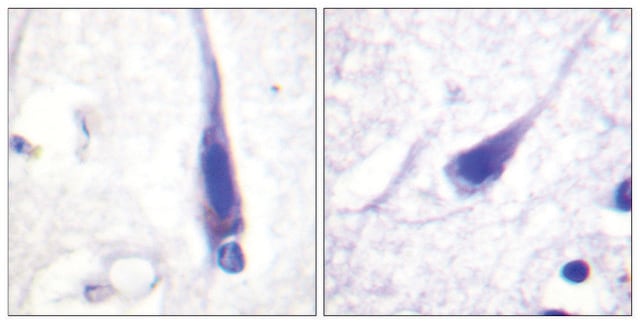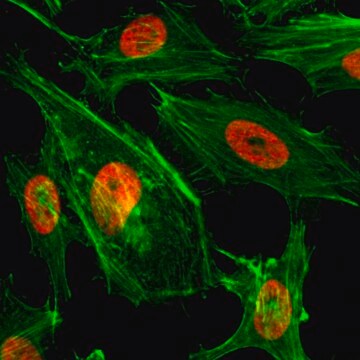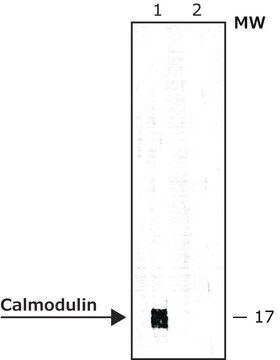05-173
Anti-Calmodulin Antibody
Upstate®, from mouse
Synonyme(s) :
calmodulin 1, calmodulin 1 (phosphorylase kinase, delta), phosphorylase kinase, delta subunit
About This Item
Produits recommandés
Source biologique
mouse
Niveau de qualité
Forme d'anticorps
purified antibody
Type de produit anticorps
primary antibodies
Clone
monoclonal
Espèces réactives
pig, mouse, vertebrates, rat, human, bovine
Fabricant/nom de marque
Upstate®
Technique(s)
immunoprecipitation (IP): suitable
western blot: suitable
Isotype
IgG1
Numéro d'accès NCBI
Numéro d'accès UniProt
Conditions d'expédition
dry ice
Modification post-traductionnelle de la cible
unmodified
Informations sur le gène
human ... CALM3(808)
Description générale
CaM mediates processes such as inflammation, metabolism, apoptosis, muscle contraction, intracellular movement, short-term and long-term memory, nerve growth and the immune response. CaM is expressed in many cell types and can have different subcellular locations, including the cytoplasm, within organelles, or associated with the plasma or organelle membranes. Many of the proteins that CaM binds are unable to bind calcium themselves, and as such use CaM as a calcium sensor and signal transducer. CaM undergoes a conformational change upon binding to calcium, which enables it to bind to specific proteins for a specific response. CaM can bind up to four calcium ions, and can undergo post-translational modifications, such as phosphorylation, acetylation, methylation and proteolytic cleavage, each of which can potentially modulate its actions.
Spécificité
Immunogène
Application
4 μg of a previous lot immunoprecipitated calmodulin from A431 RIPA cell lysate. Radioimmunoassay:
Use 10 μg/mL to detect calmodulin in the range of 200-300 ng.
Signaling
GPCR, cAMP/cGMP & Calcium Signaling
Qualité
Western Blot Analysis: 0.1-1 μg/mL of this antibody detected calmodulin in RIPA lysates from human A431 carcinoma cells. Previous lots detected calmodulin in RIPA lysates from mouse 3T3 and L6 rat skeletal fibroblasts.
Description de la cible
Liaison
Forme physique
Stockage et stabilité
Remarque sur l'analyse
Positive Antigen Control: Catalog #12-301, non-stimulated A431 cell lysate. Add 2.5µL of 2-mercaptoethanol/100µL of lysate and boil for 5 minutes to reduce the preparation. Load 20µg of reduced lysate per lane for minigels.
Autres remarques
Informations légales
Clause de non-responsabilité
Not finding the right product?
Try our Outil de sélection de produits.
En option
Code de la classe de stockage
10 - Combustible liquids
Classe de danger pour l'eau (WGK)
WGK 1
Certificats d'analyse (COA)
Recherchez un Certificats d'analyse (COA) en saisissant le numéro de lot du produit. Les numéros de lot figurent sur l'étiquette du produit après les mots "Lot" ou "Batch".
Déjà en possession de ce produit ?
Retrouvez la documentation relative aux produits que vous avez récemment achetés dans la Bibliothèque de documents.
Notre équipe de scientifiques dispose d'une expérience dans tous les secteurs de la recherche, notamment en sciences de la vie, science des matériaux, synthèse chimique, chromatographie, analyse et dans de nombreux autres domaines..
Contacter notre Service technique








